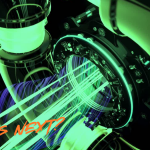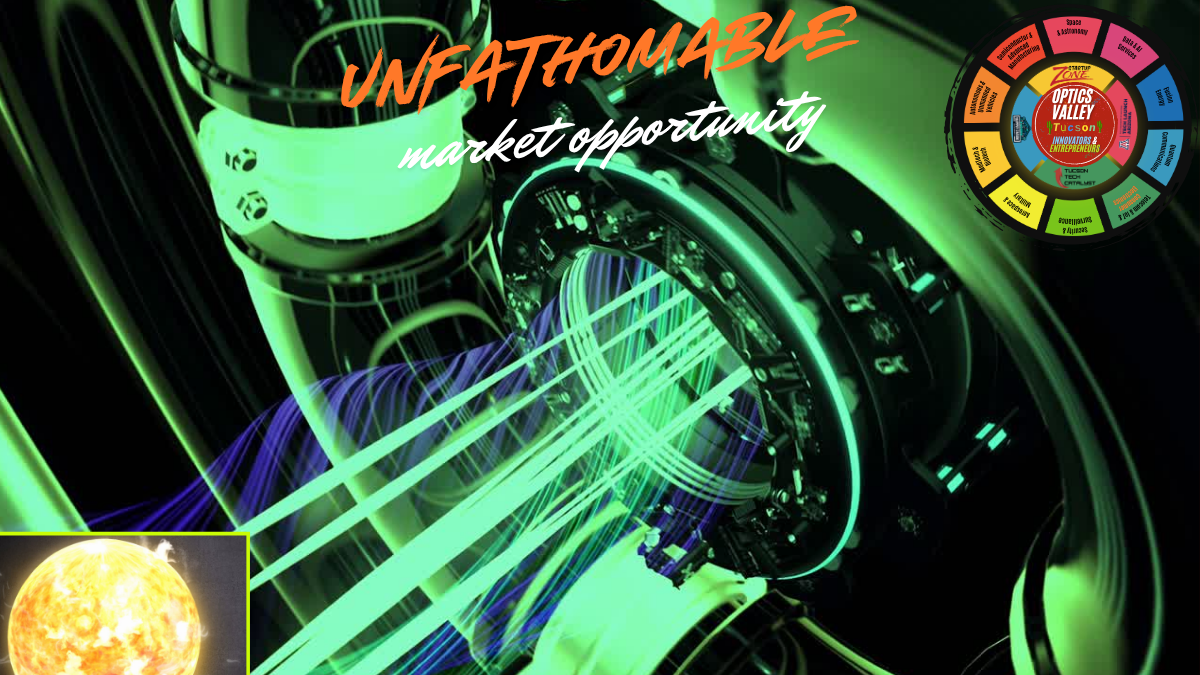America First ENERGY Revolution via FUSION
Enabled by the America First Act, the America Foundries Act, the National Defense Authorization Act, and the CHIPS Act Playbook
Imagine a future where our cities run on the same power that fuels the sun, energy that’s clean, safe, and nearly limitless. That future is closer than most people think. It’s called fusion energy, and scientists, engineers, and entrepreneurs worldwide are racing to make it a reality.
Fusion is the process that occurs inside stars when atoms of hydrogen collide and fuse, releasing enormous amounts of energy. If we can reproduce that process on Earth, we could generate electricity without the pollution, carbon emissions, or long-term radioactive waste of today’s power plants.
But achieving this feat requires not just physics, it requires light. More precisely, it depends on lasers, optics, and photonics. And that’s where Tucson (Optics Valley), Arizona, and University of Arizona’s Wyant College of Optical Sciences come in.
The Promise of Fusion Energy
Fusion energy has long been the goal for scientists seeking clean power. When two light atoms, such as hydrogen isotopes deuterium and tritium, fuse, they form helium and release vast amounts of energy. The fuel is abundant, deuterium can be extracted from seawater, and tritium can be bred from lithium.
Unlike nuclear fission (the process used in current reactors), fusion does not risk a meltdown and doesn’t produce long-lived radioactive waste. A single cup of fusion fuel could power an entire home for hundreds of years. It’s the kind of “energy abundance” that could power electric vehicles, desalinate ocean water, and supply massive data centers without harming the environment.
However, there’s a catch: fusion requires conditions found only in the hearts of stars, with temperatures exceeding 100 million degrees Celsius. Creating and controlling plasma safely on Earth is one of the most challenging tasks in science.
That’s why, according to The Hill’s article “Fusion Energy and U.S. Leadership,” the U.S. must lead the way in commercializing the technology. If it succeeds, the U.S. could revolutionize energy production, boost its economy, and secure its position as a clean-energy superpower.
Why Optics and Lasers Are the Key
To recreate the sun’s power on Earth, scientists must find ways to heat, compress, and control fusion fuel. Lasers are one of the most powerful tools for doing this.
At Lawrence Livermore National Laboratory, the National Ignition Facility (NIF) made history in 2022 when it achieved “ignition,” producing more energy from a fusion reaction than the laser energy absorbed by the target. The lasers they used were some of the most powerful ever built, firing 192 beams at a tiny capsule of hydrogen fuel.
Those beams, optics, and precision-timed pulses are all examples of photonics at work, the science of generating, manipulating, and detecting light. Without the ability to control light so precisely, fusion would remain science fiction.
Optics and photonics also aid in plasma diagnostics, enabling scientists to observe and measure what’s happening inside reactors in real-time. They’re used in sensors, imaging systems, mirrors, and coatings that can survive intense heat and radiation. In short, every primary path toward fusion, whether it’s magnetic confinement (tokamaks) or laser-driven inertial confinement, depends on optical innovation.
Optics Valley Knowledge is Power
If there’s one place that understands the power of light, it’s Tucson. Globally recognized as Optics Valley, the region is home to well over 100 companies specializing in optics, lasers, sensors, photonics, and precision manufacturing.
This tech hub grew around the University of Arizona’s Wyant College of Optical Sciences, the preeminent institution for optics research and education. The college has trained thousands of optical engineers who now work across various industries, including aerospace, semiconductor manufacturing, and defense.
Now, Tucson’s optics expertise is connecting directly with fusion energy. Local companies produce high-power laser modules, cooling systems, optical coatings, and metrology equipment that can aid in the development of next-generation reactors.
As Dr. Peter Strittmatter, former director of the Steward Observatory, once said, “The future of Tucson is written in light.” Now, that light may one day power the planet.
University of Arizona: Building the Future of Fusion
The University of Arizona has launched a Fusion Energy Strategic Initiative, aiming to accelerate research, partnerships, and workforce development. Its goals include:
- Advancing research in high-power lasers, plasma physics, and advanced materials.
- Establishing a Research, Development, Test, and Evaluation (RDTE) Center for fusion technologies.
- Creating academic and workforce programs to train optical engineers and scientists for fusion jobs.
- Building partnerships with private companies to turn research into real-world applications.
One of these partnerships is with Leonardo Electronics US Inc., which is collaborating with the University of Arizona to develop next-generation diode-pumped laser systems. These systems could be used in future fusion power plants that require laser drivers to operate efficiently and continuously.
The university has also joined the STARFIRE Hub for Inertial Fusion Energy, a national collaboration led by the Department of Energy that focuses on accelerating fusion research and commercial readiness. Through these efforts, the University of Arizona isn’t just following the fusion trend; it’s shaping it.
The Role of Workforce and Startups
Building a new energy industry requires more than labs; it needs people. Engineers, materials scientists, technicians, and startup founders all play vital roles in turning scientific breakthroughs into products and companies.
That’s why Tucson’s fusion push connects naturally with its startup ecosystem. Organizations like Startup Zones and Tech Launch Arizona are helping to bridge the gap between researchers, mentors, and companies, ensuring that Arizona’s innovations don’t just stay in the lab but reach the marketplace.
Fusion energy will open new markets for optical coatings, photonic sensors, control systems, and materials science areas where Tucson’s ecosystem already shines. By aligning its startups, university programs, and manufacturing supply chains, Tucson can become a cornerstone of the global fusion economy.
Challenges Ahead and Why the Race Matters
Fusion is difficult. Sustaining continuous power output, building materials that can withstand neutron bombardment, and making reactors cost-effective are still enormous engineering hurdles.
However, every significant scientific milestone, from flight to semiconductors, started as an “impossible” dream until technology caught up. With today’s advances in artificial intelligence, photonics, materials science, and supercomputing, that “impossible” dream is now within reach.
Thought leaders across the energy industry agree that fusion is not just about science, it’s about leadership. Countries that master fusion will control the most advanced form of energy ever created. And as The Hill article argued, “The United States cannot afford to lose its lead.”
With its deep photonics expertise and growing research infrastructure, Tucson is well-positioned to help maintain its lead.
America Must Align Policy, Capital, and Industrial Base to Win the Race
In a way, fusion energy is the ultimate expression of human curiosity, harnessing the same power that lights the stars to light our cities.
Through the University of Arizona’s leadership, the strength of Optics Valley’s companies, and the collaboration of innovators and entrepreneurs, Tucson is helping to transform that dream into reality.
The last decade taught the U.S. a hard lesson: when a strategic technology moves from the lab to the market, the country that aligns its policy, capital, and industrial base wins. For semiconductors, the groundwork was laid first through the America First Act, the America Foundries Act, and the National Defense Authorization Act (NDAA). The combination of these Acts authorized incentives for domestic fab capacity and R&D. The CHIPS and Science Act put real dollars behind those ambitions. Together, they signaled a bipartisan consensus: America can’t outsource critical technologies and remain secure or competitive.
Fusion energy, especially inertial fusion energy (IFE), powered by lasers and advanced photonics, now sits at a similar inflection point. After the National Ignition Facility’s repeated ignition shots (net energy gain), the scientific “if” has given way to an engineering “how fast.” America should not repeat the microelectronics stumble that many argue ceded manufacturing leadership abroad; instead, it should run a similar playbook for fusion fast. Anchored by the optics/photonics/laser stack that makes IFE possible and leveraging regional strengths such as the University of Arizona and Optics Valley/Tucson, we must take a leadership role in the innovation and transformation of clean energy.
Are you ready?








